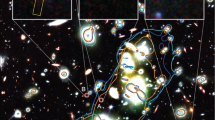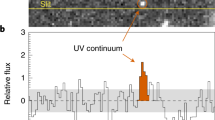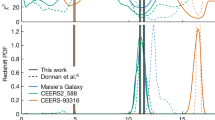Abstract
0406 + 121 is a flat-spectrum variable radio source first discovered by Shimmins et al.1 and later studied by Condon et al.2. While no optical counterpart was identified, similar sources were often found to be either BL Lac-type objects or high redshift QSOs. Recently, Rieke et al. detected the object in the near-IR, where it was observed to vary in luminosity over the six-month period between August 1978 and March 1979. A Kitt Peak 4-m plate taken on 29 November 1978 and published by Rieke et al. revealed a stellar image (V = 20.5 ± 0.4 mag) at the radio (and IR) position, which lies ∼30 arc s north of an anonymous spiral galaxy. Rieke et al. suggested that 0406 + 121 and some similar sources they detected having steep power law spectra were a possible new type of QSO discriminated against in conventional optical searches. To clarify the nature of 0406 + 121 further, we obtained a spectrum in good seeing conditions on the night of 27 February 1979 using the Steward Observatory 2.25-m telescope and intensified Reticon spectrograph. The object, clearly visible on an intensified TV guider, was wobbled every 80 s between two circular apertures 2.5 arc s in diameter spaced 20 arc s apart. Eighty-five minutes of integration time, calibration with the spectroscopic standard EG 67 (ref. 4) and a HeAr comparison lamp, and eight point smoothing of the 10 A resolution spectrum gave the results shown in Fig. 1.
This is a preview of subscription content, access via your institution
Access options
Subscribe to this journal
Receive 51 print issues and online access
$199.00 per year
only $3.90 per issue
Buy this article
- Purchase on Springer Link
- Instant access to full article PDF
Prices may be subject to local taxes which are calculated during checkout
Similar content being viewed by others
References
Shimmins, A. J., Bolton, J. G. & Wall, J. V. Aust. J. Phys. Suppl. 34, 63–83 (1975).
Condon, J. J., Hicks, P. D. & Jauncey, D. L. Astr. J. 82, 692–700 (1977).
Rieke, G. H., Lebofsky, M. J. & Kinman, T. D. Astrophys. J. Lett. 232, L151–L154 (1979).
Oke, J. B. Astrophys. J. Suppl. 27, 21–35 (1974).
Sandage, A. & Visvanathan, N. Astrophys. J. 223, 707–729 (1978).
O'Dell, S. L., Puschell, J. J. & Stein, W. A. Astrophys. J. 213, 351–355 (1977).
Rieke, G. H. & Lebofsky, M. J. A. Rev. Astr. Astrophys. 17, 477–511 (1979).
O'Dell, S. L., Puschell, J. J., Stein, W. A. & Warner, J. W. Astrophys. J. Lett. 214, L105–L109 (1977).
Puschell, J. J. et al. Astrphys. J. Lett. 227, L11–L16 (1979).
O'Dell, S. L., Puschell, J. J., Stein, W. A. & Warner, J. W. Astrophys. J. Suppl. 38, 267–286 (1978).
Author information
Authors and Affiliations
Rights and permissions
About this article
Cite this article
Aaronson, M., Boroson, T. Is 0406 + 121 the reddest BL Lac object?. Nature 283, 746–747 (1980). https://doi.org/10.1038/283746a0
Received:
Accepted:
Issue Date:
DOI: https://doi.org/10.1038/283746a0
Comments
By submitting a comment you agree to abide by our Terms and Community Guidelines. If you find something abusive or that does not comply with our terms or guidelines please flag it as inappropriate.



